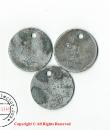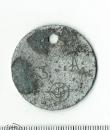KL Ravensbruck - KZ-Außenlager Velten 3 tool token come from sub-camp of KL Ravensbruck - Ikaria / Veltener Maschinenbau GmbH
| Price: | $180.00 |
KL Ravensbruck - KZ-Außenlager Velten 3 tool token with same logo and different numbers come from sub-camp of KL Ravensbruck - Ikaria / Veltener Maschinenbau GmbH .
3 tool tokens made by aluminum.
Tokens come from near Berlin / Velten Ikaria works - Velten.
The Ikaria works produced aircraft parts during the war.
It was an external warehouse of KL Ravensbrück and KL Sachsenhausen where forced laborers made the aircraft parts.
The concentration camp Velten was from March 1943 in Berliner Straße 8d in Velten and was initially subordinated to the concentration camp Ravensbrück, later the Sachsenhausen concentration camp. The female inmates had to do forced labor for the Ikaria / Veltener Maschinenbau GmbH, an important supplier of the Heinkel-Werke Oranienburg.
In March 1943, the inspection of the concentration camps in Velten had an external camp of the concentration camp Ravensbrück built. The site was chosen as the location in Berliner Straße 8d, which was located directly at the station Hohenschöpping of the Kremmener Bahn. The SS confined German, Jewish, Polish, French, Latvian, Romanian, Hungarian and Sinti and Roma prisoner wives to the six wooden barracks, which were fenced with an electric fence. The location of the camp was chosen so that the women lived near Ikaria / Veltener Maschinenbau in Berliner Straße 12b and Havelschmelzwerk GmbH in Berliner Straße 8, where they had to do forced labor. Head of the satellite camp, which was subordinate to the Sachsenhausen concentration camp from September 1944, was an SS Unterscharführer named Heinrich Loose. At the end of 1944, 722 women lived in the camp under inhumane conditions. On the night of 19 to 20 April 1945, the camp was dissolved and the inmates were driven on foot over Eberswalde in the direction of northern Germany. In early May 1945, the Red Army released the survivors at Parchim.













